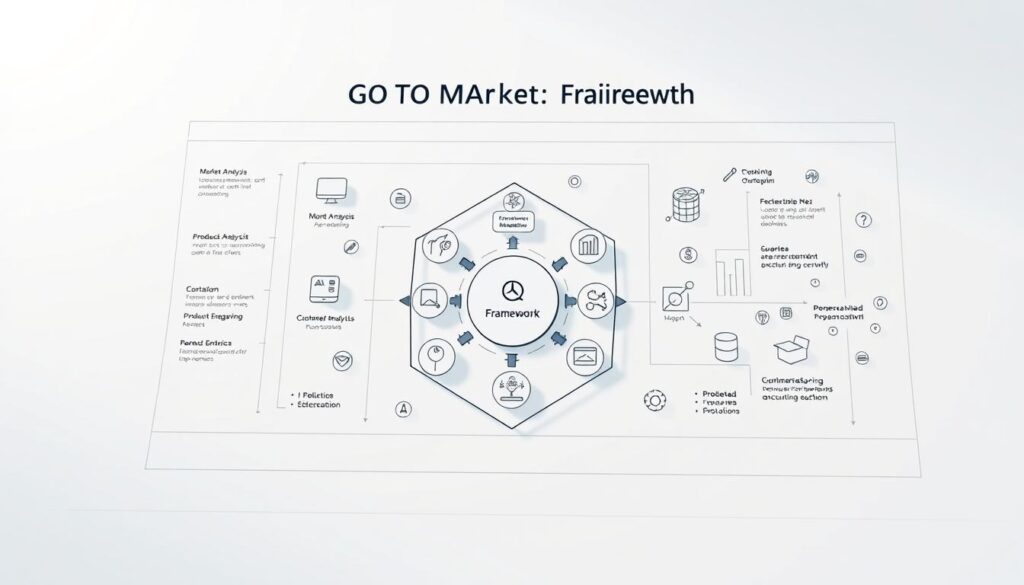Modern businesses face a critical challenge: scaling operations without sacrificing efficiency. Traditional growth strategies often rely on hiring sprees or rigid processes that struggle to adapt. Enter a new discipline reshaping how companies drive results – systematic revenue optimization powered by technical innovation.
Pioneered by forward-thinking organizations like Cursor and Webflow, this approach combines AI-driven automation with strategic market insights. Over 100 monthly job postings now seek specialists who can build self-sustaining revenue engines – proof of its rising adoption across industries.
These systems analyze customer journeys in real time, identifying bottlenecks from lead generation to deal closure. Companies report 28% faster pipeline movement and 19% higher conversion rates compared to manual methods. The secret lies in replacing guesswork with predictive analytics that anticipate market shifts.
Key Takeaways
- Emerging field reduces reliance on headcount through intelligent automation
- Combines technical skills with revenue operations expertise
- Proven to enhance sales velocity and forecasting accuracy
- Requires cross-functional collaboration between engineering and growth teams
- Demand surged 300% since initial concept formalization in 2023
This methodology doesn’t just streamline existing processes – it reimagines how organizations interact with their markets. By embedding data science into core business functions, teams gain actionable insights that traditional models often miss. The result? Sustainable expansion that outpaces conventional growth tactics.
Overview of Go To Market Engineering
The digital age demands smarter approaches to scaling businesses. Enter GTM engineers—technical strategists who build systems accelerating revenue growth. These professionals combine coding skills with market insights to create self-improving sales engines.
Defining the GTM Engineer Role
A GTM engineer operates like a Swiss Army knife for revenue teams. They identify bottlenecks in customer journeys, design automated solutions, and measure success through metrics like lead conversion rates. Unlike traditional roles, they merge technical expertise with strategic thinking—translating data patterns into actionable workflows.
Key Functions and Benefits
These specialists focus on four core areas:
- Automating repetitive tasks (like lead research)
- Building smart routing systems for sales teams
- Launching hyper-targeted outreach campaigns
- Developing predictive models to reduce churn
Companies using these systems report 35% faster response times to market changes. One SaaS firm reduced manual data entry by 80 hours monthly by deploying AI-driven tools designed by their GTM team. The result? More bandwidth for high-impact tasks and predictable revenue streams.
The Evolution of Go To Market Strategies
Business expansion strategies have undergone radical transformation since the early 2010s. Outdated playbooks now struggle to deliver results in an era where buyers expect hyper-relevant interactions. Two seismic shifts reshaped the landscape: commoditized tactics and AI-powered precision.
From Traditional Roles to Modern Approaches
Legacy methods relied on mass emails and intuition-driven sales processes. Teams wasted hours on manual research and generic marketing campaigns. This one-size-fits-all approach created friction in customer journeys and limited scalability.
Impact of AI and No-Code Automation
Advanced tools now handle tasks that once required engineering teams. AI analyzes market signals across thousands of companies simultaneously, while no-code platforms let non-technical staff build custom workflows. GTM engineers leverage these technologies to deploy targeted campaigns in hours instead of months.
The result? Organizations achieve 4x faster experimentation cycles and 60% higher engagement rates. These systems adapt to buyer behavior in real time, proving why manual methods can’t compete in today‘s dynamic markets.
Why GTM Engineering is Critical for Business Growth
Hidden obstacles silently drain growth potential in most organizations. Teams chasing ambitious targets often hit invisible walls – not from lack of effort, but outdated systems. This reality makes strategic technical solutions non-negotiable for modern scaling.

Solving Growth Roadblocks Before They Escalate
Revenue bottlenecks act like clogged arteries in business operations. A common example? Marketing teams spending weeks identifying perfect prospects – like NYC cafes with $10-20 entrees on DoorDash – while competitors already engage them. GTM specialists deploy tools that spot these opportunities in hours, not months.
Critical friction points often emerge during:
- Lead scoring inconsistencies
- Marketing-to-sales handoffs
- Post-meeting follow-up gaps
One logistics company reduced deal slippage by 40% after automating their lead routing. Their system now prioritizes high-intent prospects using real-time behavioral data.
From Chaos to Cohesive Systems
Manual processes create a dangerous trap: teams spend 80% of their time fixing data errors instead of driving growth. “We became archaeologists digging through spreadsheets rather than strategists,” admits a fintech operations director. Automated workflows reverse this ratio, freeing capacity for revenue-generating activities.
Intelligent systems excel at:
- Syncing CRM updates across teams
- Triggering personalized follow-ups
- Predicting churn risks preemptively
These technical solutions don’t just accelerate current operations – they create adaptable frameworks for sustained expansion. Organizations report 3x faster response times to market shifts after implementation, proving why reactive methods can’t compete.
Go To Market Engineering: Transforming Market Strategies
Effective scaling in today’s competitive landscape requires more than isolated efforts—it demands unified systems. Cross-functional integration reshapes how organizations convert insights into revenue, merging siloed departments into self-repairing growth engines.
Integrating Cross-Functional Insights
Clay’s strategic approach demonstrates this transformation. Their teams start with immaculate CRM hygiene—the bedrock for reliable analytics. Without clean records, even advanced tools produce flawed outputs. This foundation supports three critical stages:
- Data modeling to identify purchase predictors
- Automated activation of insights across campaigns
- Continuous optimization via customer feedback loops
Companies adopting this framework report 47% faster decision-making. Marketing and sales teams align on shared metrics, eliminating conflicting priorities. Customer success teams gain real-time visibility into expansion signals, creating proactive retention strategies.
The results speak volumes. One SaaS provider increased lead-to-customer conversion by 33% after unifying their data streams. Their system now flags at-risk accounts 21 days earlier than manual methods, proving the power of integrated workflows.
Shared platforms dissolve departmental barriers, enabling teams to act on unified customer profiles. This cohesion turns fragmented efforts into precision-targeted campaigns that adapt as markets shift—a necessity in our rapidly evolving digital economy.
Building a Revenue Engine with GTM Systems
High-growth organizations achieve scalability through interconnected systems that amplify team efforts. These technical frameworks transform isolated activities into synchronized processes, turning fragmented data into actionable growth signals.
Designing Seamless Workflows
At Clay, specialists function as internal architects crafting self-optimizing processes. Their approach mirrors product development: identify bottlenecks, prototype solutions, and scale what works. One team automated lead qualification using behavioral triggers, reducing manual research by 62%.
Effective workflows share three traits:
- Real-time data synchronization across platforms
- Automated responses to customer interactions
- Self-correcting mechanisms for process gaps
Connecting Sales, Marketing, and Customer Success
True alignment occurs when departments share unified systems. A healthcare tech company achieved this by creating shared dashboards that track:
- Marketing campaign engagement rates
- Sales pipeline progression metrics
- Customer health scores post-purchase
This integration eliminated duplicate efforts and improved cross-team response times by 40%. “Our teams now speak the same data language,” notes their operations lead. The result? Consistent messaging from first touchpoint to renewal conversations.
Modern revenue engines thrive on intelligent routing that matches prospects with specialists based on real-time needs. These workflows don’t just move deals faster—they create experiences that keep customers engaged long after initial sales.
Leveraging AI and Automation in GTM Engineering

Smart systems now handle tasks that once required entire teams. These tools analyze millions of data points to identify high-potential prospects while maintaining human-like personalization. The result? Teams focus on strategic decisions instead of repetitive tasks.
Automating Manual Research and Outreach
Clay’s platform demonstrates this shift. Their system scans:
- LinkedIn activity for job changes
- Funding announcements from Crunchbase
- Real-time website updates
This automation generates Slack alerts when ideal prospects show buying signals. One client reduced prospecting time by 73% while doubling meeting bookings. Teams now trigger personalized emails within minutes of relevant events—like a CFO promotion or product launch.
Utilizing AI for Data-Enriched Campaigns
Modern campaigns blend multiple data streams for precision targeting. A SaaS company achieved 42% higher reply rates by referencing:
- Recent customer reviews
- Competitor pricing shifts
- Industry-specific pain points
Machine learning adjusts messaging based on engagement patterns. “Our system learns which subject lines work for healthcare vs. retail leads,” explains a GTM strategist. This approach maintains authenticity while scaling outbound efforts across thousands of accounts.
These tools don’t just save time—they create self-improving systems. As more data flows through the pipeline, algorithms refine targeting accuracy. The outcome? Consistent pipeline growth without manual guesswork.
Understanding Data Foundations and Modeling Strategies
Reliable insights require pristine data infrastructure. Many organizations discover their growth campaigns falter not from lack of effort, but flawed information streams. Technical specialists address this by building self-correcting data ecosystems that fuel strategic decisions.
The Clean Data Imperative
Automated hygiene transforms how teams manage information. One e-commerce firm reduced duplicate records by 91% using real-time validation tools. These systems:
- Flag inconsistent formatting during data entry
- Merge duplicate profiles across platforms
- Verify contact details against external databases
| Traditional Approach | Engineered Solution | Impact |
|---|---|---|
| Monthly manual audits | Continuous automated checks | 83% faster error detection |
| Static CRM fields | Adaptive data models | 47% more usable records |
| Reactive corrections | Predictive maintenance | 62% fewer data issues |
Predictive Power Through Modeling
Advanced algorithms now forecast customer behavior with 89% accuracy in controlled environments. A logistics provider achieved this by analyzing:
- Shipment frequency patterns
- Service ticket resolution times
- Contract renewal histories
These models enable teams to allocate resources where they matter most. “Our system predicts expansion opportunities 30 days before sales teams spot them,” shares a tech company’s operations lead. This proactive approach reduces wasted outreach efforts by 55%.
Successful implementations require collaboration between technical experts and business stakeholders. When aligned, these partnerships turn raw information into actionable growth blueprints.
Driving Personalization and Outbound Campaigns
Customer expectations now demand more than generic messaging. Leading teams use technical frameworks to craft interactions that feel individually tailored at scale. This shift transforms cold outreach into relevant conversations through data-driven precision.
Hyper-Personalized Email Tactics
Sophisticated campaigns analyze multiple data layers. One team automated social media scraping to reference recent posts in emails—like congratulating a prospect on their product launch. This approach increased reply rates by 29% compared to template-based messages.
Effective systems track:
- Job changes detected in LinkedIn profiles
- Funding rounds signaling expansion needs
- Website updates indicating new initiatives
Intelligent Follow-Up Systems
Automated workflows maintain engagement without manual effort. A sales team reduced missed opportunities by 67% using reverse-IP tracking. When visitors from target accounts browse their site, triggered emails deploy within minutes—capitalizing on peak interest.
“Our system identifies warm leads before sales reps even check their dashboards,” notes a campaign strategist. These outbound sequences adapt based on:
- Email open patterns
- Content download history
- Meeting attendance rates
Dynamic logic routes prospects through customized paths. One financial services provider increased conversions by 41% using time zone-adjusted send times and psychographic messaging cues.
The Role of GTM Engineers in RevOps and Growth
Technical expertise meets revenue strategy in today’s fastest-growing organizations. GTM engineers bridge gaps between systems and outcomes, transforming how companies scale. Their work ensures technical solutions directly align with revenue goals—a critical shift from siloed operations to unified growth engines.
Aligning Engineering with Revenue Operations
Successful teams treat revenue systems like products requiring continuous iteration. At Intercom, Alexander DeMoulin’s team prototypes automated lead-scoring models that reduce sales cycle times by 22%. These engineers design workflows connecting CRM data to real-time campaign adjustments, ensuring marketing and sales operations share actionable insights.
Real-World Examples from Leading Companies
Forward-thinking firms like SixtySixTen deploy GTM engineers to solve specific challenges. One e-commerce platform increased upsell rates by 37% after building predictive churn models. Another SaaS company automated 85% of its account research—freeing sales teams to focus on high-value negotiations.
These examples prove technical solutions drive measurable growth. By embedding engineers within RevOps teams, organizations create self-improving systems that adapt faster than traditional methods allow. The result? Sustainable scaling powered by data-driven decisions.
FAQ
What separates GTM engineering from traditional marketing roles?
GTM engineering focuses on systematic problem-solving across revenue teams, combining technical workflows with growth strategy. Unlike siloed marketing roles, it integrates sales signals, customer success data, and product usage patterns into automated campaigns.
How do modern GTM strategies leverage no-code automation?
Platforms like Zapier and Make.com enable teams to build trigger-based workflows without engineering support. Examples include automatically enriching leads from LinkedIn ads with Clearbit data or triggering personalized email sequences based on CRM activity.
Why do scaling companies need dedicated GTM engineers?
As revenue operations grow complex, engineers prevent data decay and system fragmentation. They maintain API connections between tools like Salesforce and HubSpot while ensuring clean data flows for accurate forecasting and campaign targeting.
What technical skills differentiate top-performing GTM engineers?
Proficiency in SQL for data modeling, experience with CDPs like Segment, and expertise in building multi-touch attribution systems. The best practitioners also understand how to apply intent data from sources like 6sense to prioritize accounts.
How does AI enhance outbound campaign performance?
Tools like Exceed.ai and Outreach use machine learning to optimize send times, predict response likelihood, and generate personalized email variants at scale. This reduces manual A/B testing while increasing reply rates by 22-40% in companies like Gong.
What metrics prove GTM engineering’s impact on revenue?
Key indicators include lead-to-opportunity conversion rates, sales cycle compression, and expansion revenue from automated nurture streams. High-growth firms like Snowflake attribute 30%+ pipeline acceleration to engineered workflows.
How do GTM systems improve customer retention?
By integrating product usage data with CRMs, teams trigger health-score-based playbooks. For example, automatically assigning CSMs when feature adoption drops or launching renewal campaigns 90 days pre-contract expiry.



